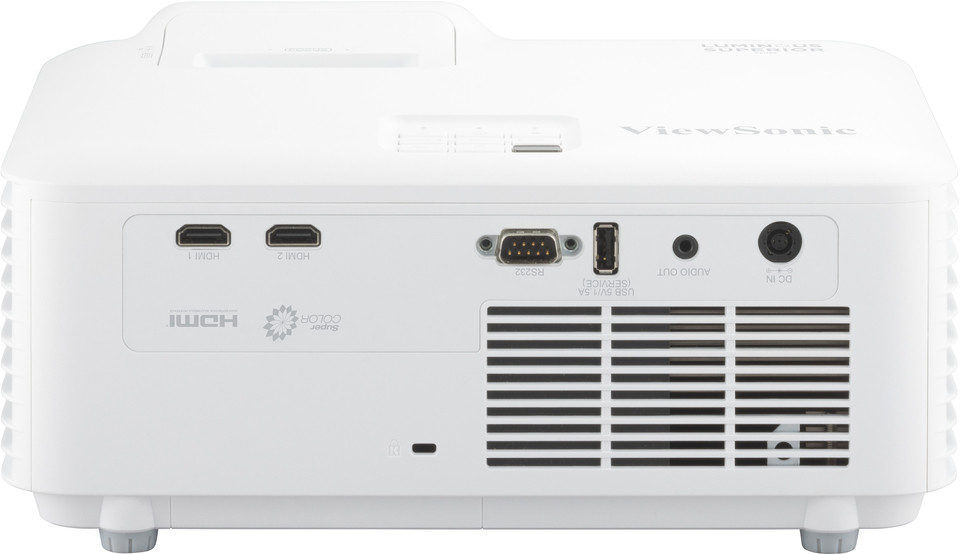































£1,095.78*
£8.99
- Light Brightness 4,200 Lumen
- Resolution 1280 x 800 WXGA
- Aspect Ratio 16:10
- Operating noise 30 dB


Frequently purchased together
Product information
The LS711W is part of ViewSonic's Luminous Superior series, a range of lamp-free, high-brightness projectors designed for commercial and educational environments. Thanks to 3rd generation laser phosphor technology, it delivers 4,200 ANSI lumens for up to 30,000 hours and guarantees bright and vivid images without lamp replacement. The lamp-free design offers an environmentally friendly and cost-effective solution, while the lightweight and compact design of the projector reduces transport costs. With a short throw ratio of 0.52, the projector can deliver a seamless image on a 100-inch screen from a distance of just 1.1 metres without shadowing, allowing for effortless edge blending to create an immersive experience. This projector features H/V keystone correction with 4-corner adjustment, 360° projection and a portrait mode for easy setup and versatile applications.
- 3rd generation laser phosphor technology with a lifespan of up to 30,000 hours
- 4.200 ANSI lumens for bright images in any environment
- High native contrast ratio thanks to 0.65-inch DMD chip from Texas Instruments
- 0.52 short throw for seamless edge blending without casting shadows
- Compact size and low weight reduce transport and installation costs
- Flexibility during installation: H/V keystone correction, 360° projection and portrait mode
Bright, compact, durable
The LS711W is equipped with advanced 3rd generation laser phosphor technology. Generation laser phosphor technology, which increases brightness by 20 % and achieves better light output. At the same time, it is 32 % more compact and easier to access than the previous generation. The lamp-free light source can be switched on and off instantly and has a service life of up to 30,000 hours without maintenance, ensuring consistent image quality even with prolonged use.
Bright images for large venues
With 4,200 ANSI lumens, the LS711W delivers vivid and sharp projections in all lighting conditions in galleries, restaurants, gyms and other large spaces.

Unrivalled contrast, enhanced visibility
The projector's high native contrast ratio, achieved by the 0.65-inch DMD chip from Texas Instruments, allows for deeper blacks and brighter whites. The result is greater visual depth, clearer images and better readability.

No shadows, no dazzling lights
The 0.52 Short Throw offers a 100" image from just 1.1 m away. When projected onto a wall, there are no distracting shadows and the seamless blending of the edges ensures an intense viewing experience.

Ultra-large screen with lower cost per inch
This easy-to-install projector allows for an image size of up to 300" and offers a lower cost per inch compared to other commercial displays.

Easy and cost-efficient installation
The LS711W is 35% lighter and 35% smaller than its predecessor and even than most competing projectors on the market, which significantly reduces transport costs and makes installation easier.
Save costs and energy
With its advanced lamp-free light source, the LS711W offers a highly energy-efficient and cost-saving display solution, consuming up to 40% less power than other projectors.
Perfectly shaped images effortlessly
Horizontal and vertical keystone correction and 4 corner adjustment functions eliminate skewed or distorted images for a perfectly proportioned picture.
Versatile creative applications
The projector can be rotated vertically at any angle, enabling projection onto ceilings, walls or floors. The portrait mode further expands the possibilities for projection mapping, staging and creative advertising applications.
Nonstop 24/7 operation
The projector's advanced cooling design enables 24/7 operation without compromising image quality or performance. This makes it the ideal solution for applications that require continuous projection in retail shops, shopping centres, museums, airports and other public spaces.
Technical data
| Name | ViewSonic LS711W Projector, 1280 x 800 WXGA, 4200 Lumen |
|---|---|
| Article number | 1000030459 |
| GTIN/EAN | 0766907022773 |
| Manufacturer SKU | LS711W |
| Lamp life (ECO) | 30,000 Hour |
| Lens included | Yes |
| Model name | LS711W |
| Projection Distance | Short Throw |
| Brand | ViewSonic |
| Product Type | Projector |
| Product Series | ViewSonic LS Series |
| Application | Business projector , Short throw projectors |
| Projector Type | DLP |
| Projector lamp type | Laser |
| ANSI Lumen | 4,200 ANSI Lumen |
| Resolution | 1280 x 800 WXGA |
| Aspect Ratio | 16:10 |
| Contrast Ratio | 3,000,000 :1 |
| Operating noise | 30 dB |
| Operating noise - ECO | 24 dB |
| Lamp life | 20,000 Hour |
| Minimum Projection Distance | 39 cm |
| Maximum Projection Distance | 337 cm |
| Minimum Projection Ratio | 0.521 |
| Maximum Projection Ratio | 0.521 |
| Horizontal Keystone | 15% |
| Vertical Keystone | 15% |
| Inputs | 1x RS232 , 1x USB-A , 2x HDMI |
| Outputs | 1x 3,5mm Jack |
| wireless technology | Not Specified |
| Features | 360° projection , Integrated speaker , Portrait Mode |
| Product width | 28.6 cm |
| Product height | 12.9 cm |
| Product depth | 21.6 cm |
| Weight | 3.15 kg |
| Colour | Black |
| Delivery contents | Lens cap , Remote control |
| Condition | New |
| Warranty | 36 Month |
| Warranty type | Pickup service Service and support information |
Downloads
Projection distance calculator
Contact our experts for help!
Image size:
Format
Format
Product safety
| Person responsible for the EU |
|---|
| ViewSonic Technology GmbH |
| Fürst-Leopold-Platz 1 |
| 46284 Dorsten |
| Germany |
| sales-uk@viewsonic.com |












